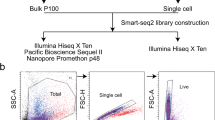Abstract
Gene expression profiles of hematopoietic stem cells (HSCs) provide clues for understanding molecular mechanisms of HSC behavior, including self-renewal and differentiation. We took advantage of serial analysis of gene expression (SAGE) to identify medium- and low-abundant transcripts expressed in HSCs/hematopoietic progenitor cells (HPCs). Among a total of 31,380 unique transcripts, 17,326 (55%) correspond to known genes and, 14,054 (45%) are low-copy transcripts that have no matches to currently known genes. Among the former class, 3,899 (23%) were alternatively spliced transcripts and 3,754 (22%) represent anti-sense transcripts from known genes. Mapping of the SAGE tags to the mouse genome showed that differences in gene expression exist among chromosomes. In addition, comparison of the HSCs/HPCs SAGE data to that of myeloid progenitor cells revealed that massive genetic reprogramming occurs in hematopoietic cell differentiation. Our results demonstrate a previously unrecognized complexity of gene expression in HSCs/HPCs, and indicate the need for further efforts to fully identify and characterize the transcripts expressed in this cell type.


Similar content being viewed by others
References
Agoulnik IU, Vaid A, Nakka M, Alvarado M, Bingman WE 3rd, Erdem H, Frolov A, Smith CL, Ayala GE, Ittmann MM, Weigel NL (2006) Androgens modulate expression of transcription intermediary factor 2, an androgen receptor coactivator whose expression level correlates with early biochemical recurrence in prostate cancer. Cancer Res 66:10594–10602
Akala OO, Clarke MF (2006) Hematopoietic stem cell self-renewal. Curr Opin Genet Dev 16:496–501
Chen JJ, Rowley JD, Wang SM (2000) Generation of longer cDNA fragments from serial analysis of gene expression tags for gene identification. Proc Natl Acad Sci USA 97:349–353
Chen J, Rowley DA, Clark T, Lee S, Zhou G, Beck C, Rowley JD, Wang SM (2001) The pattern of gene expression in mouse Gr-1(+) myeloid progenitor cells. Genomics 77:149–162
Chen J, Sun M, Lee S, Zhou G, Rowley JD, Wang SM (2002) Identifying novel transcripts and novel genes in the human genome by using novel SAGE tags. Proc Natl Acad Sci USA 99:12257–12262
Cheung AM, Kwong YL, Liang R, Leung AY (2006) Stem cell model of hematopoiesis. Curr Stem Cell Res Ther 1:305–315
Dennis G Jr, Sherman BT, Hosack DA, Yang J, Gao W, Lane HC, Lempicki RA (2003) DAVID: Database for Annotation, Visualization, and Integrated Discovery. Genome Biol 4:P3
Forsberg EC, Prohaska SS, Katzman S, Heffner GC, Stuart JM, Weissman IL (2005) Differential expression of novel potential regulators in hematopoietic stem cells. PLoS Genet 1:e28
Huttmann A, Duhrsen U, Heydarian K, Klein-Hitpass L, Boes T, Boyd AW, Li CL (2006) Gene expression profiles in murine hematopoietic stem cells revisited: analysis of cDNA libraries reveals high levels of translational and metabolic activities. Stem Cells 24:1719–1727
Ivanova NB, Dimos JT, Schaniel C, Hackney JA, Moore KA, Lemischka IR (2002) A stem cell molecular signature. Science 298:601–604
Lash AE, Tolstoshev CM, Wagner L, Schuler GD, Strausberg RL, Riggins GJ, Altschul SF (2000) SAGEmap: a public gene expression resource. Genome Res 10:1051–1060
Lee S, Bao J, Zhou G, Shapiro J, Xu J, Shi RZ, Lu X, Clark T, Johnson D, Kim YC, Wing C, Tseng C, Sun M, Lin W, Wang J, Yang H, Du W, Wu CI, Zhang X, Wang SM (2005) Detecting novel low-abundant transcripts in Drosophila. RNA 11:939–946
Lemischka IR, Pritsker M (2006) Alternative splicing increases complexity of stem cell transcriptome. Cell Cycle 5:347–351
Megy K, Audic S, Claverie JM (2002) Heart-specific genes revealed by expressed sequence tag (EST) sampling. Genome Biol 3:RESEARCH0074
Oritani K, Aoyama K, Tomiyama Y, Kincade PW, Matsuzawa Y (2000) Stromal cell CD9 and the differentiation of hematopoietic stem/progenitor cells. Leuk Lymphoma 38:147–152
Park IK, He Y, Lin F, Laerum OD, Tian Q, Bumgarner R, Klug CA, Li K, Kuhr C, Doyle MJ, Xie T, Schummer M, Sun Y, Goldsmith A, Clarke MF, Weissman IL, Hood L, Li L (2002) Differential gene expression profiling of adult murine hematopoietic stem cells. Blood 99:488–498
Ramalho-Santos M, Yoon S, Matsuzaki Y, Mulligan RC, Melton DA (2002) “Stemness”: transcriptional profiling of embryonic and adult stem cells. Science 298:597–600
Romualdi C, Bortoluzzi S, D’Alessi F, Danieli GA (2003) IDEG6: a web tool for detection of differentially expressed genes in multiple tag sampling experiments. Physiol Genomics 12:159–162
Scheetz TE, Raymond MR, Nishimura DY, McClain A, Roberts C, Birkett C, Gardiner J, Zhang J, Butters N, Sun C, Kwitek-Black A, Jacob H, Casavant TL, Soares MB, Sheffield VC (2001) Generation of a high-density rat EST map. Genome Res 11:497–502
Shojaei F, Trowbridge J, Gallacher L, Yuefei L, Goodale D, Karanu F, Levac K, Bhatia M (2005) Hierarchical and ontogenic positions serve to define the molecular basis of human hematopoietic stem cell behavior. Dev Cell 8:651–663
Su ZZ, Shi Y, Fisher PB (1997) Subtraction hybridization identifies a transformation progression-associated gene PEG-3 with sequence homology to a growth arrest and DNA damage-inducible gene. Proc Natl Acad Sci USA 94:9125–9130
Wang SM (2007) Understanding SAGE data. Trends Genet 23:42–50
Wilson A, Trumpp A (2006) Bone-marrow haematopoietic-stem-cell niches. Nat Rev Immunol 6:93–106
Zhang Y, Liu XS, Liu QR, Wei L (2006) Genome-wide in silico identification and analysis of cis natural antisense transcripts (cis-NATs) in ten species. Nucleic Acids Res 34:3465–3475
Acknowledgments
This work was supported by the SRC Program of the Korea Science and Engineering Foundation (KOSEF) grant funded by the Korea Government (2009-0063409) and WCU (World Class University) Program through the Korea Science and Engineering Foundation funded by the Ministry of Education, Science and Technology (R33-2008-000-10070-0).
Author information
Authors and Affiliations
Corresponding author
Additional information
Communicated by P. Ruiz.
Electronic supplementary material
Below is the link to the electronic supplementary material.
Rights and permissions
About this article
Cite this article
Kim, HS., Hwang, J., Kim, YH. et al. Detection of low-abundant novel transcripts in mouse hematopoietic stem cells. Mol Genet Genomics 282, 363–370 (2009). https://doi.org/10.1007/s00438-009-0469-z
Received:
Accepted:
Published:
Issue Date:
DOI: https://doi.org/10.1007/s00438-009-0469-z




